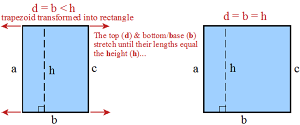And although it may not yet be obvious from our latest results (which are)...
| P = | 2b + 2h | & | A = | bh |
|
a scarcely detectable amount; an extremely small quantity |
|---|

| P = | 2l + 2w | & | A = | lw |
|
revealed its presence or having made an appearance; demonstrated |
|---|
For a square, it is very much the same type of transformation as the one we have just seen with
the rectangle (in that the parallel sides need to coincide in horizontal position and length). It needs also be the case that this pair of sides have their lengths match exactly the height of the trapezoid, regardless of whether that requires the shrinking or stretching of the sides (labeled "b" & "d," in the illustrations for each possibility).

 In either case, once the square is formed then, all sides are now the same length, meaning that:
a = b = c = d = h.
Substituting the quantity "h" for all the other variables (a, b, c & d) in both of
In either case, once the square is formed then, all sides are now the same length, meaning that:
a = b = c = d = h.
Substituting the quantity "h" for all the other variables (a, b, c & d) in both of